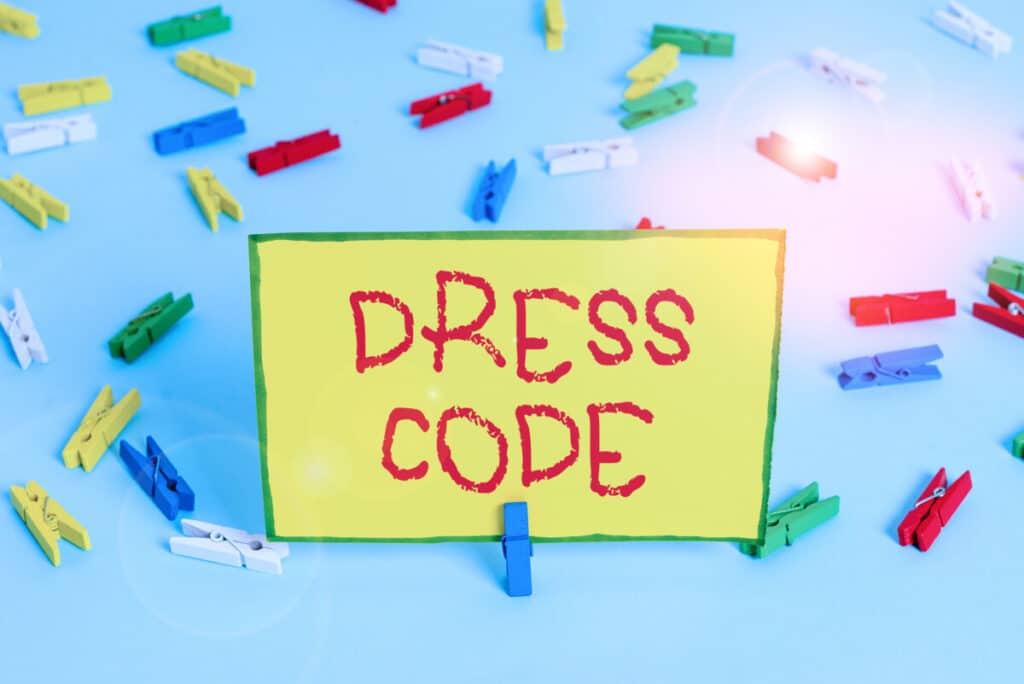Dress Codes in Schools: The Statistics on if They Actually Work
Are you a student, upset with your school’s dress code, wondering what the point of it all is? Or are you a teacher, trying to see if the dress code is worth enforcing in your classroom? Maybe you’re a parent, doing your research to see if you should speak against the dress code at the next opportunity?
Despite complaints, dress codes have been shown to improve the learning environment through their improvement of student safety and student behavior. The result is increased academic results, better student behavior, and preparation for the professional world.
Let’s look at the results of some studies done on the effectiveness of dress codes, how to properly implement them so that they’ll work properly, and the benefits of a good dress code. For clarity, “dress code” will refer to a strict dress code though the remainder of the article unless otherwise specified.
Findings: Exam Scores
A study done in Pennsylvania re-instituted a dress code in one of the school districts there to see the effects it had on academic performance. This study also took into account other similar experiments.
The logic behind a dress code as a solution was that improvement of any kind in student safety and conduct would result in a better learning environment, so exam scores should be improved.
They found an increase in test scores in multiple schools that had adopted dress codes, with the high school having significant success. This suggests that dress codes can have great success in improving the learning environment, especially in high schools, where fashion and/or rebellious dress can be more prevalent and distracting than in earlier schools.
For reference, this came from a research paper by Patricia Blanding-Stewart from Saint Joseph’s University in 2015.
Findings: Student Safety
Safety is more commonly brought up as a good reason for dress codes, whether for identification of students or for preventing students from bringing hidden weapons to school.
Schools are responsible for keeping their students safe, and dress codes are a less intrusive way of doing that than metal detectors, security guards, and badges.
Items that pose a risk include headwear, outerwear, jewelry/accessories, footwear, and sunglasses.
Headwear and sunglasses can obscure the wearer’s identity and block the student’s vision. Outerwear can conceal weapons. Some jewelry and accessories can be used as weapons themselves. Footwear with wheels, rollers, or cleats can also pose threats to student safety, sometimes even the wearer’s safety, as well as school property. (Source)
Implementation: Clarity
The study from earlier by Blanding-Stewart noted that the most effective means of implementation, or communicating the dress code to the students, involved a PowerPoint illustrating items of clothing that were and were not allowed.
This visual aid supported the written and verbal instructions and gave students a clear picture of how they could and couldn’t dress. In fact, even students who might have otherwise resisted the dress code accepted it after the PowerPoint presentation.
It’s always easier to follow a rule when you understand it. When students understand the dress code, they will be more willing to follow it, and visual examples of what is and isn’t accepted will help them understand the line between what they can and can’t wear, so they’ll know the area they have to work with instead of having to guess.
Implementation: Discipline
Of course, you only get the benefits of a dress code if it’s properly enforced. Some schools send students out of class (or just back home) to change. Others give them something to wear for the duration of the school day. Some might just give detentions.
Whether any of these are the right way to do it may depend on the students, and whether violations are frequent or not. If the students don’t care enough about the consequences, they won’t bother following the rules, and sending the students home too frequently will detract from their education and distract the rest of the class.
Whatever the school decides is the appropriate way to uphold the dress code, it’s important that teachers support it and go through with it. This may sound harsh, but students need to know that the dress code is serious and that they won’t get away with it.
On that topic, teachers should be sure that every student who violates the dress code needs to be told so, boys and girls.

Benefit: Protect Students
Bullying/Being Singled Out
Dress codes can protect students from being bullied in a number of ways. For one, if a popular fashion trend breaks the dress code, students won’t be targeted for going against it because the school won’t allow it, and those who follow the trend will be disciplined.
Dress codes can protect students from being picked on for being poor, or otherwise apart from the group. When students all have the same dress code to follow, clothing becomes a null and void area of discrimination.
Gangs and Violence
Typically, dress codes prohibit the expression of messages that can interfere with the learning of other students, and this includes gang symbols. When gang symbols are prohibited and absent, students will feel safer and not threatened.
Schools that have trouble with gangs or violence in general often implement a dress code as one of their solutions. Part of such a dress code often bans outerwear, such as coats and jackets (which can be used to hide weapons), as well as accessories with spikes or chains that could be used to hurt other students or the school property.
Quick Identification
Dress codes concerned with safety are also used to help distinguish between students and intruders, though I find the effectiveness of this questionable, as someone who knows and prepares for the dress code wouldn’t have a problem fitting in. On the other hand, an intruder who didn’t know the dress code would be easier to spot.
Uniforms likely work the best for this purpose, and implementing a dress code for the teachers as well would help students be able to identify an adult intruder.
Benefit: Promote Good Behavior
While there may be some who think the dress code isn’t worth enforcing, there’s something to be said for keeping even small rules in check. I’m not saying that the dress code is a small rule, only that showing that you’re serious about small rules also shows that you’re serious about bigger rules.
On the other hand, if you’re lenient about the dress code, students will take that as a hint that they can get away with other things. They’ll break rules they think are less important than the dress code without thinking twice about it, and the daring ones might try to overturn some more serious rules and see how far they can push the envelope.
In short, discipline through the dress code translates to the rest of the school rules and promotes good behavior from the students.
Benefit: Help Students Pay Attention
Though boys who break the dress code have an easier time fixing a violation (e.g. pulling up saggy pants or turning their shirt inside out to hide a vulgar message), advocates against dress codes claim that dress codes also discriminate against boys as a result of the dress code’s argument that girls dressing in revealing clothing distract them, a sexist degradation of boys. (Source)
But that argument fails to hold water for a simple reason: revealing clothing can be distracting to anyone. As a young girl, I was distracted and bothered when I saw another girl in revealing clothing, and it took time to get the image out of my head so that I could return my focus to my work.
While I can’t speak for everyone, I have to expect any young, impressionable child who trusts the rules to have a similar experience in that kind of situation.
Think about it: if someone were to interrupt you while you were working, would you be more distracted by someone in a revealing dress or in modest clothes?
But it’s not just other students who can affect a student’s attention. A girl in scanty clothes has a lot more to think about than one who’s comfortably covered: she has to stop her skirt from riding up, make sure not to squat, and keep her tank top straps from falling down. Can you imagine trying to focus on a test while dealing with those distractions?

Benefit: Prepare Students for the Professional World
Take a second to think about what schools are for. They’re there to give students an education so that they can enter the professional world, so by extension they should be focused on preparing students to get jobs.
When you want to get a job, you dress up for the job interview. Dressing over-casually, trashily, or scantily could cost you the job before they even ask you the first question. No one wants to fail a job interview just because the interviewer didn’t see past their clothes, but hey, you had been warned about that already.
Then there’s the job itself to think about. While many jobs may not have as strict a dress code as some schools, many other jobs are even stricter or have uniforms.
Would you trust a doctor in a tank top with no coat? No, you’d think they just walked in without any qualifications! Not to put words in your mouth, but we’ve been brought up in a world where doctors have a dress code, so a student who wants to be a doctor shouldn’t be surprised when they have to wear that uniform.
Benefit: Allow Expression?
A mandatory uniform is the only dress code that doesn’t allow for personal expression. In fact, a strict dress code makes for the most creative potential a student can have for their apparel.
Consider poetry, specifically form poetry. When you read a poem, and the vivid details shine out through the strict form, that’s a work of incredible art there. All those words fit together to produce something beautiful in both meaning and sound.
Now to take it back to dress codes. You may not be allowed ripped or sagging jeans, leggings, or a shirt that shows the collarbone, but there’s a lot more to clothes than the shape.
There are colors, patterns, and clever graphics. If you want to be even more personal, you could design a printed shirt or do some tie-dye. Then there’s merch from your favorite fandom or YouTube creator and even commemorative t-shirts. All these variables are up to you for showing people who you are and what you like.

Common Conflict: Are Dress Codes Sexist?
One of the biggest arguments against dress codes is their “discrimination” against girls. Leggings and short skirts are usually not allowed, and if you break the dress code, you have to leave school to change into something else. (Source)
Enforcing this rule would certainly cause a scene that breaks some attention, but is it really that hard to wear pants? And if you do get sent home for this, (and you don’t like being sent home) are you really going to break that rule again?
On the other hand, dress codes rarely have restrictions that cut off boys from fashion trends they may or may not want to follow, as wearing pants and a t-shirt is generally a given for them.
Setting any fashions aside, it should be just as easy for girls to follow a dress code as boys.
If self-expression or fashion is a big concern of yours, though, all you need is a little creativity. Under any dress code short of a mandatory uniform, you have room to make choices. In fact, strict rules make a space for creativity to thrive, and such parameters can inspire you to create something you never would have thought of otherwise.
So, are dress codes sexist? Maybe, but so are magazine covers, fashions, and even advertisements. So if you want to complain about sexism, complain about it where it’s detrimental instead of harping on a school rule that can help students avoid other sources of sexism.

